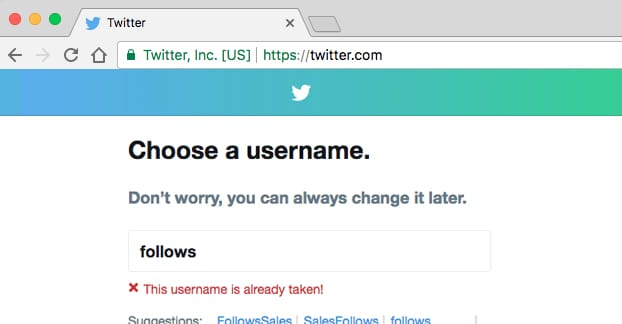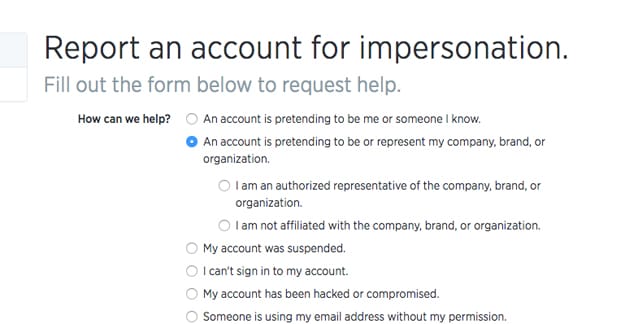If you’re just getting into Twitter marketing, or you’re starting a new brand and want to pick up a relevant twitter account, you’re fairly likely to run into some issues. Twitter is one of those sites where so many people have been using it for so long that it can be difficult to register a username you want.
Now, say your new brand is The Blog Wanderer. You might do some research and decide that you really want @wanderer. Unfortunately, when you look, that account already exists. It hasn’t posted since 2011, but it exists and is not suspended. You could decide to add numbers to it, but something like @wanderer2 also exists – though it hasn’t tweeted before – and besides, the numbers make your branding look unprofessional. Going with the full name, @blogwanderer, also exists, though it’s in French and is much more active.
How can you go about trying to claim one of these URLs as your own?
First of all, you probably won’t be able to.
There’s a persistent myth on the internet that you can kind of just go in and claim an account that’s not active. The fact is, it’s very rare. The reason articles about it are so popular is because the few success stories are rare and unique.
Using the three examples above, I can tell you right now that there is a very low chance that you could get @blogwanderer. They have a valid claim to their URL, and you don’t have a preexisting trademark. @wanderer2 might be possible, but again, you lack a trademark and there’s no way to tell if the account is actually active or not. @wanderer certainly appears inactive, and you could perhaps argue a trademark, but I wouldn’t count on it.
About Inactivity
Twitter takes inactivity pretty seriously, but they have a lot more information about it than you do. An account that tweeted last month might now be inactive, but an account that hasn’t tweeted in a year could still be active.
The reason is that there are all kinds of other actions an account can take that aren’t visible to the public. The user might regularly hold conversations with people in DMs, and just never tweet publicly. They might be used to run ads but not organic posts. They might be used to enter contests, and just delete the contest posts that apps make.
According to the official policies, an account is flagged as inactive if the user does not log in for six months. Even if you log in more regularly, Twitter might also flag you as inactive if you haven’t tweeted. After all, they do want to encourage people to actually use their social network.
There are a few ways you can try to get an account that exists transferred to your name, but be warned: they don’t have a very high success rate.
Option 1: Asking or Paying the Account Owner
The first potential method you can use for getting an account is to try to contact the person who currently owns the account. This can be difficult, though, depending on how much information the user has added to their account.
If the account is active, you have both the best and the worst time of it. You’re in luck, because it means there’s an active user behind the username, as with @blogwanderer above. There’s someone there, clearly, who you can contact. Send them a DM and present to them your case: you’re a brand and you want a username that matches your brand.
You have a hard time in this scenario, though, because often times a lot of people won’t want to simply hand over their account. They might have their own personal branding going into it, or they might just be attached to the username.
You can potentially offer to pay the user for the name, either directly or indirectly. It’s against the Twitter rules to buy or sell Twitter usernames, but as long as the deal is done privately, they have no way of knowing. If you can find an amount of money that is sufficient to pay off the owner of the account and leave them satisfied, go ahead and do it.
One more “legit” way of paying for a Twitter account is to hire on the user who owns it to run it for you. That’s what CNN did for the @CNNBrk account, which was run by a fan as a breaking news feed. CNN decided they wanted it, and the owner – who had grown it to a million followers – signed a contract to run it for them. Thus, CNN obtains control over the account, and the previous owner gets paid for it, and paid quite well, without violating Twitter policies. This all happened back in 2009, though, so you might not be able to pull it off today.
If the account is not active, sending them a DM might be your only option. For the @wanderer2 account above, there’s no contact information available, so you have no alternative for reaching out to them. They might respond, or they might not, and you are completely at their mercy.
It’s possible, if the Twitter handle is unique enough, that you can “stalk” the user in other ways. Google the username and see if it shows up posted on non-Twitter websites, or if it’s listed in the profile information for one or another website or community. It could be attached to a more active or relevant Facebook or Instagram account, or it could be listed on some web forum as part of contact information.
In these cases, you can attempt to reach out to the user through those other methods, or follow the chain of usernames to a more active profile. It’s possible that you detective up the wrong person, but it’s also possible that you contact them and they say “oh, yeah, I don’t care here’s the password.”
Option 2: Filing a Trademark Dispute
The second method – and the only one officially allowed by Twitter – is the trademark dispute.
This is easiest if you happen to already have the trademark for your brand and you’re legitimately working to build that brand. The longer you’ve had that brand and the more established it is, the better off you’ll be.
Twitter has an official page on trademark violations and policies. When you report a trademark violation, Twitter might take no action if they decide you don’t have a strong enough case. If they decide you have a case, they may allow the account to change its information, which may or may not include the username. They might also just suspend the account.
One thing that is not a trademark violation is someone outside your region using your trademark. The @blogwanderer French account is one such example; even if you’re covered under US trademark law, you don’t necessarily have a case in France.
If you do think you have a trademark case, you can fill out the support form for it here.
You might notice that none of the options that Twitter takes is “give you the account.” IF Twitter decides to force the account to change its information, and IF that account has to change its username, you MIGHT be able to swoop in and register it for yourself. Or you might not. It’s always up in the air.
The reason is that a lot of people started exploiting this method to try to claim accounts. Articles like this one would show you how to do it:
- Register a domain name that matches the account you want to have.
- Build a site that looks active to fulfill trademark basics.
- Show that you’ve been using a similar but worse branded username on Twitter and would like to change over.
- Make your case for why the branding is important to you.
This technique worked for a while, but there are other people posting that they’ve tried the same thing and that Twitter now seems wise to the scheme.
Also, Twitter does not consider an inactive username, like @wanderer2, to be a trademark violation. Trademark violations in general must be attempting to copy or impersonate you. This is covered under Twitter’s rules about username squatting. Specifically, “if an account has had no updates, no profile image, and there is no intent to mislead, it typically means there’s no name-squatting or impersonation. Note that we will not release squatted usernames except in cases of trademark infringement.”
Option 3: Social Engineering
If you Google “social engineering” you’ll begin to see the direction I’m talking about here, and you should realize it’s a bad idea.
Social engineering is essentially hacking. It’s a modern version of hacking because, while it might take weeks, months, or years to brute force a password, and it might take immense resources or deep coding knowledge to compromise a web server, it’s a lot easier to “hack” a person.
Social engineering is where you send someone an email from @paypaul.com that looks like a PayPal email asking them to reset their password, which sends them to a fake but real-looking password reset screen, which harvests their information and gives it to you. Congrats, you just convinced them to give you access to their PayPal account.
Social engineering is even easier in person. Throw on an orange vest, print off an official-looking name tag, and carry a clipboard, and you’re well-suited to get in just about anywhere. Just make up a story about being part of building maintenance or a cable company contractor and you’re good to go. Most people won’t even question you, because it’s not their job to do so. As long as you look good enough to get past security, you can do just about anything virtually unchallenged.
Now, of course, social engineering is completely illegal. If you get caught attempting it, there will be penalties, anywhere from the closure of your Twitter account up to actual legal action and potential fines or jail time. I’m not in any way recommending that you pursue this option, nor do I condone it.
I’m just saying that, in the past, it has worked. There was a high profile example of it from Naoki Hiroshima, who owns – or owned – the username @N. A few years ago, someone essentially called up PayPal and GoDaddy, got enough information from one to verify with the other and vice versa, and took over the Twitter account. You can read all about it from Naoki’s report, here.
I’m not actually sure what happened since then, but Naoki has control over his account again, so whoever stole it was not able to keep it. That alone should tell you that this technique isn’t valid, if all of the illegal steps they had to take to acquire it weren’t enough.
Around the Rules
There’s one other option, but honestly it’s just not accessible. It’s not something just anyone can do. Basically, all you need to do is be big enough, important enough, and have enough money that you can tell Twitter what to do and they’ll back down from their policies. Obviously, only a small handful of companies in the world have that kind of power, and they all have their Twitter usernames already.
If, though, you want to simply change your Twitter handle to something that hasn’t been taken, you can do that pretty easily. Also, if your profile was suspended for one reason or another, it’s possible to recover it, but the process can be tricky.
As for hijacking an account, active or not, that you want because of branding? Honestly, you’re probably out of luck.








